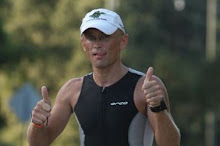Sunday I got early for a build up triathlon event - not to participate (still lacking my tri bike), but to help out and meet some of the people from the Cayman Islands Triathlon Association.
See some pictures from the event here and get an impression of what it was like. There are not many picture of me, but if you do manage to find me you will see I am wearing a white cap, black shorts and a grey t-shirt (and holding a water bottle). There will be two more build up events before the olympic distance triathlon late November.
Monday, October 15, 2007
Wednesday, October 10, 2007
Ironman Triathlon World Championships
 Lately, I have been giving some thought to triathlon training and my goals. One event I am very keen on doing is the Ironman World Championships in Kona Hawaii. The race encompasses a 2.4 mile (3.86 km) ocean swim in Kailua-Kona Bay, followed by a 112 mile (180.2 km) bike ride in the Hawaiian lava desert and ending with a marathon (42.195 km) along the coast. The event is coming-up this weekend so keep your eye out for media coverage.
Lately, I have been giving some thought to triathlon training and my goals. One event I am very keen on doing is the Ironman World Championships in Kona Hawaii. The race encompasses a 2.4 mile (3.86 km) ocean swim in Kailua-Kona Bay, followed by a 112 mile (180.2 km) bike ride in the Hawaiian lava desert and ending with a marathon (42.195 km) along the coast. The event is coming-up this weekend so keep your eye out for media coverage.Hawaii was host to the first Ironman Triathlon in 1978. If you have triathlon ambitions, Kona is definitely on the list of races you want to participate in. Entrance to Kona is on a qualification only basis. Here there are two main options, a lottery or to participate in a race that allocates slots to Kona.
Of course you could rely on pot luck, but since you want to complete the damn thing and do so in a reasonable time, you might as well try and estimate what the qualification requirements might be. This turns out to be a difficult task because of the way the system works. Luckily there are people out there like Neil Hammond who posted his analysis of qualification times on the internet. Now, Hammond's analysis is far from perfect, but it gives results that seem plausible to me. Indeed by using his analysis I cross-checked my initial thinking and came to more or less the same result.
Without making things too complicated these are the type of times I would need to qualify in the 35-39 age group (+/- 5%). 1:15 for the swim, 5:20 for the bike ride and 3:40 for the run. This adds up to 10:15, add to that 10 minutes in transition and my qualifying time is just under 10.5 hours. +/- 5% gives me a qualifying interval of roughly 10 - 11 hours. Is that possible? I certainly believe it is. Swimming 3.8 km in 1:15 should be fairly easy not least because it is in the beginning of the race. 180 km in 5:20 is just under 34 km/h. While my legs would not be able to cope with that currently, because I haven’t trained on the distance, that can be rectified with purposeful training. The part of the race that causes me most worry is the marathon. I am not sure how my legs or indeed body will react. I got a taste during the Brisbane marathon, but that was without more than 6 hours psychical exertion prior to start. However, as long as I can keep my legs running 3:40 should be possible.
Here are some stats from Kona for a comparison:
2006 WINNERS:
Normann Stadler - S 54:05, B 4:18:23, R 2:55:03, Total 8:11:56
Michellie Jones - S 54:29, B 5:06:09, R 3:13:08, Total 9:18:31
COURSE RECORDS:
1996 – Luc Van Lierde (BEL) 8:04:08
1992 – Paula Newby-Fraser (ZIM) 8:55:28
FASTEST COURSE TIMES:
Swim
1998 – Lars Jorgensen (USA) – 46:41
1999 – Jodi Jackson (USA) – 48:43
Bike
2006 – Normann Stadler (GER) – 4:18:23
1993 – Paula Newby-Fraser (ZIM) – 4:48:30
Run
1989 – Mark Allen (USA) – 2:40:04
1999 – Lori Bowden (CAN) – 2:59:16
I would of course not compete with the elite but in the age groups. The men’s division records are:
Age Record Name Age Year
18-24 8:55:02 Vassilis Krommidas 24 1994
25-29 8:41:02 Maximilian Longree 25 2006
30-34 8:45:59 Igor Kogoj 34 1993
35-39 8:47:02 Jim Beuselinck 39 2006
40-44 8:58:55 Bent Andersen 42 2006
45-49 9:11:56 Brian Keast 45 2005
50-54 9:26:23 Kevin Moats 51 2006
55-59 9:47:29 Reinhold Humbold 57 2005
60-64 10:40:49 Takahisa Mitsumori 62 2005
65-69 11:29:45 Milos Kostic 65 2006
70-74 12:59:02 Bob Scott 71 2001
75-79 13:27:50 Bob Scott 75 2005
80+ 16:21:55 Robert McKeague 80 2005
Robert McKeague is amazing. 80 years old and doing an Ironman. I wonder if Bob Scott will try to beat his record in 2010.
First things first though. Step one is to successfully complete the distance, if that can result in qualification to Kona that would be exceptional, but more likely a second attempt will be necessary. My timeframe is 3 years.
Anyway, you don’t get any faster writing blogs. Better to do some training instead! This video provides some good motivation.
Subscribe to:
Comments (Atom)




